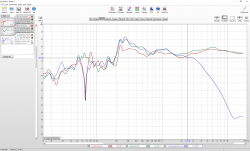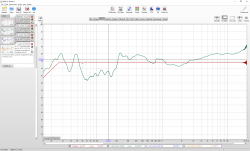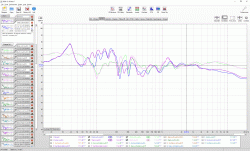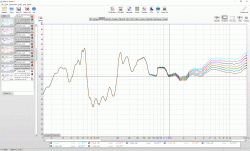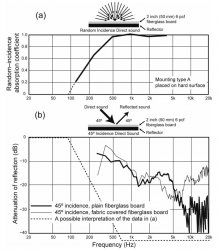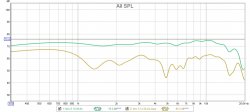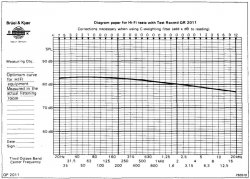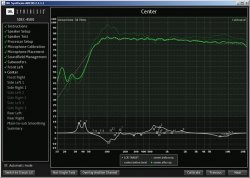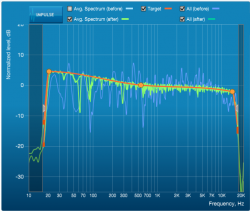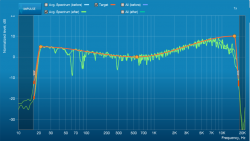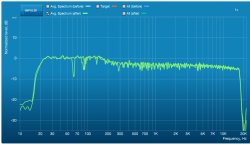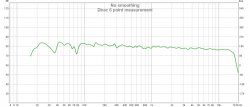Last night I had the master volume on my AVP set too high without realizing it. I ran a frequency sweep 20-20kHz with my UMIK-1 facing the ceiling and 90 degree cal file from the MLP, which is about 13.5 feet from the speakers. Because the MV was set way to high, REW showed a warning in red "0.0 dB headroom" and after the measure showed the warning that the results would be unreliable. That's understandable, as the mic was overpowered. Unfortunately, so was the tweeter...
As a result, I blew out the tweeter and I now have to repair the speaker. Normally I run the sweeps with the MV around -25dB to -20dB (IIRC). I had the MV up at -8.5dB because I was doing some Level adjustments. Then I forgot to lower it. Whoops! When I moved on to the frequency sweeps, the volume was still set at -8.5dB. In the measurement graph the FR nosedived starting right at the 2.5kHz crossover to the tweeter. I knew right away that the tweeter was toast.
Although the MV of -8.5dB is way too high for a frequency sweep, I do wonder why exactly it blew the speaker. These speakers can play at reference from 13.5 feet to the MLP. And it's not like the MV was at 0dB. -8.5dB uses far less amp power. One possible reason is that Audyssey XT32 has applied +8.5dB to the high frequencies in my calibration. So with the MV at -8.5dB, but Audyssey adding a boost of 8.5dB, it was more like closer to 0dB I guess? But even then, I would still think that the tweeters could handle this. Unless a speaker playing real movie/music content at 0dB reference is totally different than a speaker trying to handle a full spectrum frequency sweep at the same reference level, which perhaps is far more brutal on the speaker? I have read online that running a frequency sweep too loud can blow a tweeter, but I am wondering what level is considered "too loud". Well in my case I know what that level is but I am wondering if this is a normal level or if the speaker should have been fine at that level and instead by loud levels they are referring to MV of 0 or higher?
but I am wondering if this is a normal level or if the speaker should have been fine at that level and instead by loud levels they are referring to MV of 0 or higher?
I'd love to hear your guys thoughts on this and whether it makes sense given the above that the tweeter blew out. Or whether you think that the tweeter should still have survived. Ultimately I am less concerned about blowing a tweeter when using REW (because I will be much more aware of the volume in the future) and more concerned about blowing a tweeter while playing real content at or near reference. Which I also did recently as a result of an Atmos music track, but that time I had the levels set +3dB too high on the speakers that blew, along with the Audyssey boost, so the speaker may have gotten peaks far above reference...
And now on to the feature request please.... It would be FANTASTIC if REW allowed us to set a threshold for the Headroom, so that if that threshold was crossed, REW would immediately stop the frequency sweep and display a warning. For instance I would likely set this threshold around 3dB - so that if at any point in the sweep it had less headroom then that, it would immediately abort the sweep and stop the signal. If REW had this feature, it would have saved my tweeter.
Its definitely not the fault of REW that the tweeter blew and certainly operator error here. I will definitely be a lot more careful to check the MV in the future before doing sweeps. But oversights do happen, and as much as I like to think I wouldn't do this again, it only takes one slip to lose a speaker.
What do you think?
Thanks!!
As a result, I blew out the tweeter and I now have to repair the speaker. Normally I run the sweeps with the MV around -25dB to -20dB (IIRC). I had the MV up at -8.5dB because I was doing some Level adjustments. Then I forgot to lower it. Whoops! When I moved on to the frequency sweeps, the volume was still set at -8.5dB. In the measurement graph the FR nosedived starting right at the 2.5kHz crossover to the tweeter. I knew right away that the tweeter was toast.
Although the MV of -8.5dB is way too high for a frequency sweep, I do wonder why exactly it blew the speaker. These speakers can play at reference from 13.5 feet to the MLP. And it's not like the MV was at 0dB. -8.5dB uses far less amp power. One possible reason is that Audyssey XT32 has applied +8.5dB to the high frequencies in my calibration. So with the MV at -8.5dB, but Audyssey adding a boost of 8.5dB, it was more like closer to 0dB I guess? But even then, I would still think that the tweeters could handle this. Unless a speaker playing real movie/music content at 0dB reference is totally different than a speaker trying to handle a full spectrum frequency sweep at the same reference level, which perhaps is far more brutal on the speaker? I have read online that running a frequency sweep too loud can blow a tweeter, but I am wondering what level is considered "too loud". Well in my case I know what that level is
I'd love to hear your guys thoughts on this and whether it makes sense given the above that the tweeter blew out. Or whether you think that the tweeter should still have survived. Ultimately I am less concerned about blowing a tweeter when using REW (because I will be much more aware of the volume in the future) and more concerned about blowing a tweeter while playing real content at or near reference. Which I also did recently as a result of an Atmos music track, but that time I had the levels set +3dB too high on the speakers that blew, along with the Audyssey boost, so the speaker may have gotten peaks far above reference...
And now on to the feature request please.... It would be FANTASTIC if REW allowed us to set a threshold for the Headroom, so that if that threshold was crossed, REW would immediately stop the frequency sweep and display a warning. For instance I would likely set this threshold around 3dB - so that if at any point in the sweep it had less headroom then that, it would immediately abort the sweep and stop the signal. If REW had this feature, it would have saved my tweeter.
Its definitely not the fault of REW that the tweeter blew and certainly operator error here. I will definitely be a lot more careful to check the MV in the future before doing sweeps. But oversights do happen, and as much as I like to think I wouldn't do this again, it only takes one slip to lose a speaker.
What do you think?
Thanks!!







